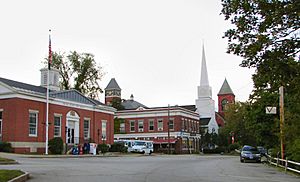Plymouth, New Hampshire facts for kids
Quick facts for kids
Plymouth, New Hampshire
|
||
|---|---|---|
|
Town
|
||

Town center (left to right): Plymouth Post Office, Rounds Hall of Plymouth State University (in background), Plymouth Congregational Church, Town Hall
|
||
|
||
| Motto(s):
Bridging the Lakes Region and the White Mountains
|
||

Location in Grafton County, New Hampshire
|
||
| Country | United States | |
| State | New Hampshire | |
| County | Grafton | |
| Incorporated | 1763 | |
| Named for | Plymouth Colony, Massachusetts | |
| Villages |
|
|
| Area | ||
| • Total | 28.6 sq mi (74.2 km2) | |
| • Land | 28.1 sq mi (72.8 km2) | |
| • Water | 0.5 sq mi (1.4 km2) 1.94% | |
| Elevation | 520 ft (160 m) | |
| Population
(2020)
|
||
| • Total | 6,682 | |
| • Density | 238/sq mi (91.8/km2) | |
| Time zone | UTC−5 (Eastern) | |
| • Summer (DST) | UTC−4 (Eastern) | |
| ZIP Code |
03264
|
|
| Area code(s) | 603 | |
| FIPS code | 33-62660 | |
| GNIS feature ID | 0873702 | |
Plymouth is a town in Grafton County, New Hampshire, in the White Mountains Region. It's an important center for business, healthcare, and culture in the area. Plymouth is located where the Pemigewasset and Baker rivers meet, at the base of the White Mountains.
In 2020, about 6,682 people lived here. Plymouth is home to Plymouth State University, Speare Memorial Hospital, and Plymouth Regional High School. The main part of town, called the Plymouth census-designated place (CDP), had 4,730 residents in 2020. Most of these residents are college students.
Plymouth State University, right in the center of town, has many students. In the 2023/2024 school year, it had over 3,300 undergraduate students and more than 500 graduate students.
Contents
History of Plymouth
Plymouth was first home to an Abenaki village. In 1712, during a war, Captain Thomas Baker burned this village. The town was later named "New Plymouth" after the original Plymouth Colony in Massachusetts.
Colonial Governor Benning Wentworth gave the land for Plymouth to soldiers who fought in the French and Indian War. Some of these soldiers were from Plymouth, Massachusetts. The town officially became a town in 1763. Later, parts of nearby towns like Hebron and Campton were added to Plymouth in 1845 and 1860.
In 1806, a young lawyer named Daniel Webster lost his first court case at the Plymouth courthouse. This building now holds the Historical Society. The famous author Nathaniel Hawthorne passed away in Plymouth in 1864 while on vacation with former U.S. President Franklin Pierce. He was staying at the second Pemigewasset House, which later burned down in 1909.
In the early 1900s, the Draper and Maynard Sporting Goods Company (D&M) in Plymouth sold sports gear directly to the Boston Red Sox. Famous baseball players like Babe Ruth would even visit to pick out their equipment!
Plymouth is also known for its history in education. The Plymouth Normal School opened in 1871. It was the first college in New Hampshire to train teachers. Over the years, it grew and changed its name several times. It became Plymouth Teachers' College in 1939, Plymouth State College in 1963, and finally Plymouth State University in 2003.
Geography and Climate
Plymouth covers about 74.2 square kilometers (28.7 square miles). Most of this area is land, with a small part being water. The town is watered by the Pemigewasset River and its smaller river, the Baker River. These rivers are part of the larger Merrimack River system.
Plymouth Mountain is the highest point in town, reaching about 668 meters (2,193 feet) high. The main village of Plymouth is about 9.7 square kilometers (3.7 square miles) in size.
Plymouth's Weather
Plymouth has a warm-summer humid continental climate. This means it has warm summers and cold, snowy winters. The hottest temperature ever recorded in Plymouth was 39 degrees Celsius (102 degrees Fahrenheit) on July 5, 1897. The coldest temperature was -39 degrees Celsius (-38 degrees Fahrenheit) on February 3, 1898.
| Climate data for Plymouth, New Hampshire, 1991–2020 normals, extremes 1887–2007 | |||||||||||||
|---|---|---|---|---|---|---|---|---|---|---|---|---|---|
| Month | Jan | Feb | Mar | Apr | May | Jun | Jul | Aug | Sep | Oct | Nov | Dec | Year |
| Record high °F (°C) | 65 (18) |
63 (17) |
81 (27) |
92 (33) |
96 (36) |
100 (38) |
102 (39) |
98 (37) |
95 (35) |
88 (31) |
82 (28) |
65 (18) |
102 (39) |
| Mean daily maximum °F (°C) | 28.8 (−1.8) |
33.1 (0.6) |
41.2 (5.1) |
54.7 (12.6) |
67.0 (19.4) |
75.1 (23.9) |
79.9 (26.6) |
78.7 (25.9) |
71.8 (22.1) |
58.4 (14.7) |
45.5 (7.5) |
33.7 (0.9) |
55.7 (13.1) |
| Daily mean °F (°C) | 18.1 (−7.7) |
20.6 (−6.3) |
29.6 (−1.3) |
41.7 (5.4) |
53.2 (11.8) |
61.9 (16.6) |
67.1 (19.5) |
65.2 (18.4) |
58.2 (14.6) |
46.0 (7.8) |
35.2 (1.8) |
24.3 (−4.3) |
43.4 (6.4) |
| Mean daily minimum °F (°C) | 7.4 (−13.7) |
8.2 (−13.2) |
17.8 (−7.9) |
28.8 (−1.8) |
39.4 (4.1) |
48.7 (9.3) |
54.2 (12.3) |
51.7 (10.9) |
44.6 (7.0) |
33.6 (0.9) |
25.0 (−3.9) |
14.9 (−9.5) |
31.2 (−0.5) |
| Record low °F (°C) | −35 (−37) |
−38 (−39) |
−25 (−32) |
2 (−17) |
18 (−8) |
22 (−6) |
33 (1) |
29 (−2) |
18 (−8) |
1 (−17) |
−13 (−25) |
−29 (−34) |
−38 (−39) |
| Average precipitation inches (mm) | 3.20 (81) |
2.62 (67) |
3.15 (80) |
3.34 (85) |
3.70 (94) |
4.43 (113) |
4.46 (113) |
3.83 (97) |
3.55 (90) |
4.56 (116) |
3.58 (91) |
4.03 (102) |
44.45 (1,129) |
| Average snowfall inches (cm) | 18.0 (46) |
15.7 (40) |
13.5 (34) |
3.4 (8.6) |
0.0 (0.0) |
0.0 (0.0) |
0.0 (0.0) |
0.0 (0.0) |
0.0 (0.0) |
0.3 (0.76) |
3.2 (8.1) |
14.2 (36) |
68.3 (173.46) |
| Average precipitation days (≥ 0.01 in) | 12.5 | 8.7 | 10.5 | 10.3 | 13.5 | 13.3 | 13.3 | 11.8 | 11.6 | 12.4 | 11.7 | 11.7 | 141.3 |
| Average snowy days (≥ 0.1 in) | 9.2 | 6.3 | 5.7 | 1.5 | 0.0 | 0.0 | 0.0 | 0.0 | 0.0 | 0.2 | 1.9 | 6.4 | 31.2 |
| Source 1: NOAA | |||||||||||||
| Source 2: XMACIS2 | |||||||||||||
People of Plymouth
| Historical population | |||
|---|---|---|---|
| Census | Pop. | %± | |
| 1790 | 625 | — | |
| 1800 | 743 | 18.9% | |
| 1810 | 937 | 26.1% | |
| 1820 | 983 | 4.9% | |
| 1830 | 1,175 | 19.5% | |
| 1840 | 1,282 | 9.1% | |
| 1850 | 1,290 | 0.6% | |
| 1860 | 1,407 | 9.1% | |
| 1870 | 1,409 | 0.1% | |
| 1880 | 1,719 | 22.0% | |
| 1890 | 1,852 | 7.7% | |
| 1900 | 1,972 | 6.5% | |
| 1910 | 2,200 | 11.6% | |
| 1920 | 2,353 | 7.0% | |
| 1930 | 2,470 | 5.0% | |
| 1940 | 2,533 | 2.6% | |
| 1950 | 3,039 | 20.0% | |
| 1960 | 3,210 | 5.6% | |
| 1970 | 4,225 | 31.6% | |
| 1980 | 5,094 | 20.6% | |
| 1990 | 5,811 | 14.1% | |
| 2000 | 5,892 | 1.4% | |
| 2010 | 6,990 | 18.6% | |
| 2020 | 6,682 | −4.4% | |
| U.S. Decennial Census | |||
In 2010, Plymouth had 6,990 people living in 1,953 households. About 95.6% of the people were White. Other groups included African American, Native American, and Asian residents. About 1.9% of the population was Hispanic or Latino.
The average household had about 2.41 people. Many households (50.1%) were not families, meaning they might be individuals or groups of friends living together, like college students.
The population of Plymouth is quite young. In 2010, about 50.4% of the people were between 18 and 24 years old. The average age was 21.7 years. This is because of the large number of students at Plymouth State University.
Fun Things to Do in Plymouth
Plymouth offers many places for outdoor activities and fun!
- Fox Pond Park
- Langdon Park and Walking Trails
- Walter-Newton Natural Area
- Sutherland Hiking Trail (on Plymouth Mountain)
- Plymouth Skate Park
- Quincy Bog
- Livermore Falls Hiking and River Jump
Places to Visit in Plymouth
There are several interesting spots to check out in Plymouth:
- Boy Scout Fountain on the Common (This is one of only two Boy Scout Fountains in the entire USA!)
- The Flying Monkey Movie House and Performance Center (This used to be the Plymouth Theater.)
- Fox Park
- Lamson Library at Plymouth State University
- Pease Public Library
- Plymouth Historical Museum
- Russell House (This is the oldest house still standing in town. It's now used by Plymouth State University for admissions.)
- Smith Millennium Bridge (a covered bridge over the Baker River)
Famous People from Plymouth
Many notable people have connections to Plymouth:
- William F. Batchelder (1926–2019), a judge on the New Hampshire Supreme Court.
- Henry W. Blair (1834–1920), a US senator and congressman.
- Eliza Coupe (born 1981), an actress known for TV shows like Happy Endings and Scrubs.
- Marian Douglas (1842-1913), a poet and writer.
- William A. Fletcher (1788–1852), who was the Chief Justice of the Michigan Supreme Court, was born in Plymouth.
- Robert Frost (1874–1963), a very famous American poet.
- Harl Pease (1917–1942), a World War II pilot who received the Medal of Honor.
- Daniel Webster (1782–1852), a well-known US senator and congressman from Massachusetts.
Images for kids
See also
 In Spanish: Plymouth (Nuevo Hampshire) para niños
In Spanish: Plymouth (Nuevo Hampshire) para niños








